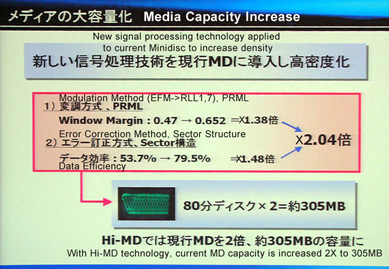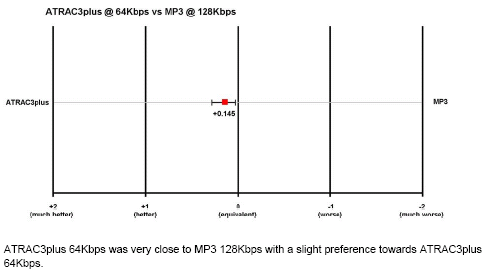 |
 |
What new capabilities does Hi-MD equipment provide vs. the existing Minidisc?
What is "Domain Wall Displacement Detection" (DWDD)?
Domain Wall Displacement Detection is one of a class of optical readout methods called Magnetic Super Resolution ("MSR"). MSR techniques address the fact that Magneto-optical systems can write much finer than they can read; magnetic domains ("bits") can be recorded on the disk that are smaller than the laser spot*, such domains cannot be read back directly since the laser spot will illuminate several domains at once.
|
DWDD Conceptual Diagram (Courtesy Canon) |
In DWDD, the recording medium is actually a 3 layer sandwich consisting of (from top to bottom) the displacement (aka readout) layer, the switching layer, and the memory layer. When the switching layer is heated to its Curie temperature (which is below the Curie temperatures of the memory and readout layers), it allows a small magnetic domain in the memory layer to appear larger than it really is in the readout layer.
The Magnetic Super Resolution technique was first discovered by Sony, and Sony has a DWDD patent that references 4 Canon patents. See Canon's DWDD explanation for further information.
[*Magneto-optical systems like Minidisc that use Magnetic Field Modulation are able to record domains smaller than the laser spot because they actually create crescent shaped regions that are magnetized as the recording layer cools below its Curie temperature. The size of these regions is determined by the switching rate of the signal sent to the magnetic head. See Sony's pictoral description of MO systems].
How did Sony increase capacity on the existing Minidisc to 305MB?

|
| Sony diagram from Hi-MD announcement Photo courtesy AV Watch |
Several changes were responsible for the increase in capacity:
What audio encodings and capacities exist on Hi-MD media?
On Hi-MD media, these audio encodings can be created:
| Encoding Mode | Recording capacity(1) | Created by ... | ||
|---|---|---|---|---|
| 305MB Hi-MD formatted Minidisc | 1GB Hi-MD Media | recording with Hi-MD equipment | downloading from PC to Hi-MD equipment | |
| Linear PCM 1.4mbps | 28m | 1h 34m | O yes | X no |
| ATRAC3plus 256kbps "Hi-SP" | 2h 20m | 7h 55m | O yes | O yes |
| ATRAC3plus 64kbps "Hi-LP" | 10h 10m | 34h | O yes | O yes |
| ATRAC3plus 48kbps | 13h 30m | 45h | X no | O yes |
| ATRAC3 132kbps "LP2" | 4h 50m | 16h 30m | X no | O yes |
| ATRAC3 105kbps | 6h 10m | 20h 50m | X no | O yes |
| ATRAC3 66kbps "LP4" | 9h 50m | 32h 50m | X no | O yes |
| ATRAC 292kbps "SP" | Not supported on Hi-MD media | |||
Note: (1)As stated in Sony literature
For calculating available Hi-MD capacity when using a mix of recording modes, Peter Ravn has made a Javascript-based Hi-MD space planning calculator.
What happens if I try to play a Hi-MD formatted disk in a non-Hi-MD machine?
A non-Hi-MD machine can read neither the 1GB Hi-MD media nor an original Minidisc reformatted in Hi-MD format. The result depends upon which of these two are used:What happens if I try to record on a 1GB Hi-MD blank with a non-Hi-MD machine?
The unit will report a read error and will not read/write on the Hi-MD disc.What is the audio quality of ATRAC3plus?
Updated: At Sony's Hi-MD annoucement they showed a chart depicting the relative standing of their ATRAC codecs. The diagonal lines indicate the audio quality equivalence of today's ATRAC3plus at 64kbps with the first version of ATRAC (ca. 1992) at 292kbps:

|
| Sony diagram from Hi-MD announcement Photo courtesy AV Watch |
The first generation ATRAC was a far cry from the quality of Type-R DSP for ATRAC introduced in 1998, and in fact it was probably similar in quality to MP3 at 128kbps. This view is supported by scientific listening experiments conducted on Sony's behalf by Intertek Testing Services (UK) and TESTFactory (Germany). Both reports showed a near equivalency of ATRAC3plus at 64kbps with MP3 at 128kbps:

|
| From ITS Test Report, showing near equivalency of ATRAC3plus@64kbps and MP3@128kbps |
If indeed ATRAC3plus at 64kbps is equivalent to MP3 at 128kbps this is good news for two reasons: 1) 1GB blanks will be able to hold 34 hours of audio equivalent to MP3@128k and 2) ATRAC3plus at 256kbps should be quite good, and quite likely better than original ATRAC at 292kbps.
Can I drag and drop ATRAC files between a Hi-MD system and a PC?
No, SonicStage and SimpleBurner must be used to transfer audio between a PC and Minidisc.Hi-MD Flash website (Japanese) has this diagram (click to enlarge):
How fast will I be able to transfer music from my PC to an MD with SonicStage?
Sony says that downloading can run at up to 100X realtime (assuming 48kbps audio content).What are the technical specifications of the Hi-MD disks?
Here are the specifications for the original Minidisc, its Hi-MD formatted version, the Hi-MD 1GB disk, and (for comparison) Sony's 650MB "MD-View" disk that was used in their Minidisc camcorder.
| Current MD format | Existing MD formatted into �Hi-MD� | Hi-MD 1GB Disc | MD-View (from MD Discam) | |
|---|---|---|---|---|
| Data Capacity | 177MB | 305MB | 1.0GB | 650MB |
| Magneto-Optical Recording Method | Magnetic Field Modulation | Magnetic Field Modulation | Domain Wall Displacement Detection | Magnetic Field Modulation on two layer medium (record layer and record assist layer) |
| Laser Wavelength (λ) | 780nm | 780nm | 780nm | 655nm |
| NA of Objective Lens | 0.45 | 0.45 | 0.45 | 0.52 |
| Diameter | 64.8mm | 64.8mm | 64.8mm | 64.8mm |
| Thickness of Substrate | 1.2mm | 1.2mm | 1.2mm | 1.2mm (but with new substrate resin) |
| Tracking Format | Groove Recording | Groove Recording | Groove Recording | Groove Recording |
| Addressing | Wobbling Groove (ADIP) | Wobbling Groove (ADIP) | Wobbling Groove (ADIP) | Interlaced Wobbling Groove (ADIP with 1 address per track) |
| Data Modulation | EFM | 1-7RLL | 1-7RLL | 1-7RLL |
| Data Detection | Bit by Bit | PRML | PRML | Bit by Bit |
| Bit Length | 0.59μm | 0.44μm | 0.16μm | 0.34μm |
| Shortest Mark Length | 0.83μm | 0.58μm | 0.21μm | |
| Track Pitch | 1.5μm | 1.5μm | 1.25μm | 0.95μm |
| Data Transfer Rate | 1.25Mbps @1.2m/s | 4.37Mbps @2.4m/s | 9.83Mbps @1.98m/s | 9.4Mbps |
What websites have Hi-MD information?
English: Japanese:
Return to the Minidisc Community Page